By Brandes Elitch
In the previous column we related how our hero discovered a Bugatti while in military service in France and brought it home to Florida. He towed it to California to begin restoration at the same time he was a graduate student at Stanford University. He then acquired a Lancia Aurelia Spider and joined Hayden Shepley’s American Lancia Club as member number 7. We pick up the story in 1970 after he has graduated, married and is living in Carmel Valley, California. By now he has traded the Spider for an Aurelia Gran Turismo coupe, better suited to commuting to his job in Monterey. One day he saw an ad in the Monterey Herald newspaper for a 1954 Maserati 2 liter spider (S/N 2101). He had always coveted a Maserati, but already had the Bugatti and Lancia in the garage. A friend advised him that he really needed to have an open car because the other two were coupes. When he asked his wife for her opinion she replied, “The main vices in your character are the ones in the garage. Go ahead and buy what you really want!” It should be obvious to any car enthusiast that when this happens it is proof you married the right person.
The seller turned out to be a “hippie” who lived in a travel trailer with his girlfriend. The car was stored in his mother’s garage in Carmel. As Mr. G. tells the story;
“When I saw the car, I was both fascinated and appalled. It was a spectacularly beautiful roadster with the “Zagato” logo on the side. One fender was badly bent, the glass in the instrument panel was smashed, and all the wires under the dash were hanging down in a tangle. I asked the kid’s mother if she knew anything about it. She said, ‘He trashed it in a drunken rage after running into a tree. After his father died, I always gave him everything he wanted. I can’t understand why he never takes care of things.’ To top it off, the girlfriend had painted a huge flower on the decklid.”
The kid had paid several thousand dollars for the car a year before, but said he needed money right away. It was not possible to start the engine or otherwise tell anything about the mechanical condition, but Mr. G. figured he could sell the parts if all else failed. His offer of $800 was reluctantly accepted as he was the only person who answered that ad. The main thing was to get it out of there before the seller changed his mind. He quickly called a friend who had a trailer for his small SCCA formula race car. Mr. G had to do some frantic cutting and hacking to get the spider on board but he managed, promising to fix and paint the trailer later. By then it was 5 pm and they got it home just before dark.
He tracked down the previous owner, a retired Air Force jet pilot who had bought the car from an American diplomat in Paris. Before bringing it back to the States, the jet pilot drove it to the Maserati factory in Italy. The chief test engineer told him that it was serial number one of about two dozen examples with coachwork by Zagato, but this was the only roadster. It was unveiled at the 1955 Geneva Motor Show and sold on the stand to a visitor, none other than Juan Peron of Argentina. The factory asked Peron if they could delay delivery because they wanted to display it at the upcoming motor shows in Paris, London, and Rome and Peron agreed. Unfortunately for him, during this interval he was deposed and exiled so the factory kept it for another two years, just in case he regained power. Failing that, the factory sent it back to Zagato for some freshening up, and then sold it to the American diplomat.
In the book, Zagato, Seventy Years in the Fast Lane, [Georgio Nada, Vimodrone, 1989], author Michele Marchiano recounts that time; “The fifties were legendary years for Zagato. It was a decade characterized by an amazing number of new models and a unique atmosphere surrounding the little works at Via Giorgini. …“La Zagato” became a major reference point for the most important racing stables of the day. … Ugo Zagato noted, “Our work is purely that of the artisan, and the abundance or scarcity of orders is down to chance and not to steady demand from the market, as is the case when producing more popular mass produced products.” Fortunately, they got an order for twenty cars from Maserati in the Viale Ciro Menotti.
Maserati introduced the A6G series in 1947. It had a 1.5 liter sohc motor with iron block and aluminum alloy cylinder head, steel tubular frame, wishbone front suspension, and live rear axle. Three examples were shown at the 1951 Paris Motor Show. Only 16 cars were made in this series. In 1953 Gioacchino Colombo joined Maserati from Ferrari and developed a 2 liter all-alloy dohc version for the A6/GCS sports racer. The third iteration began in 1954, called the A6G/54 with chain driven cams and a wet sump, producing 150 bhp at 6000 rpm via sidedraft Webers. Also called the A6G/2000 there was a convertible and coupe by Frua, an Allemano notchback coupe, and Zagato “fastback” coupes except for sole spider prototype. The Zagato weighed only 840 kg, enabling the car to exceed 125 mph. Aside from the spider described here, there were 19 Zagato coupes, each of which was unique, and only 40 other cars in this series. The A6 was superseded by the well-known 3500GT.
We resume the story.
“When I examined my prize, I was anxious to see if it would run. First I had to sort out and re-connect all the wires under the dash. The battery was dead, hidden inside the right front fender, with an access plate under the carpet on the passenger side. With a new battery it started right away and sounded just fine. I repaired the damaged instruments using glass faces ordered from a clockmaker catalog. I got wiper motors, fixed the brakes and headlights. It took quite a while to carefully straighten the fender as best I could with carved blocks of wood and a rawhide leather mallet, so as not to stretch the aluminum. After spending the previous twenty years working on the Bugatti, to do a proper restoration was not a realistic proposition. I knew better than to start down that path again.”
“Now that it was drive-able I was afraid to park it anywhere, because the bodywork was so delicate. You could see dents in it where people had leaned on it in the past. I would get up at 6 AM on a Sunday morning and go from Carmel Valley over Los Laureles Grade to the Monterey-Salinas highway and back. This road rises 1500 feet and back down for six miles. I wore driving gloves and imagined myself competing in the Mille Miglia and Targa Florio. Then I would put it back in the garage before there was any traffic. I really enjoyed the fact that the speedometer was in front of the passenger, along with the clock. Let the passenger worry about what time it is and how fast we are going! In front of the driver was just the tach and another instrument combining fuel, temp, and oil pressure gauges. Also the metal ‘H’ gate for the gear shift was a nice vintage touch. As far as I was concerned, it was easily the equivalent of a T55 Bugatti, my long-time dream car.”
Ten years later he put the car up for sale, along with the Bugatti and the Lancia, and started a new chapter in his life, as all of us must do at some time or another. Twenty-five years went by before he saw it again, when it won Best of Show at the Concorso Italiano during the Monterey Historics. He spoke to the restorer who did the work, for the same owner to whom he had sold it. It had been repainted in the original blue-green color. The American pilot had found that it blended with reflections from the smooth blacktop roads of France, and after a few near-misses had the car repainted a bright red.
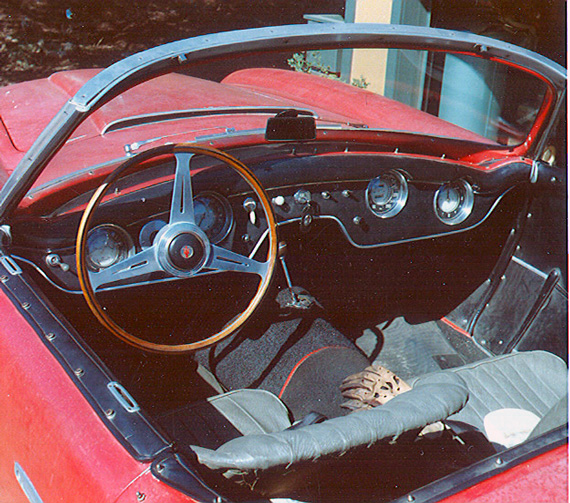
Interior was a bit of a mess but the missing glass was replaced. The new owner put the black vinyl on the dash. It was originally the same grey vinyl as the seats, but was ripped away and beyond repair. He also added the aluminum strips at the edge to hold the vinyl in place as it was a thicker texture and kept trying to pull loose.
A new book came out in 2013 called Maserati Zagato, by Walter Baumer. Mr. G sent an email to the author. He replied, “Your former car was sold and recently shown at the famous Villa d’Este Concours d’Elegance at Lake Como. I will send you some photos.” In November 2013 it appeared again as part of an exhibit and auction at Sotheby’s in New York entitled “Art of the Automobile.” It sold for $4,455,000.
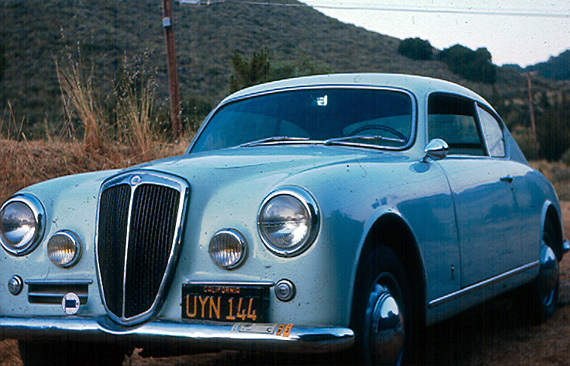
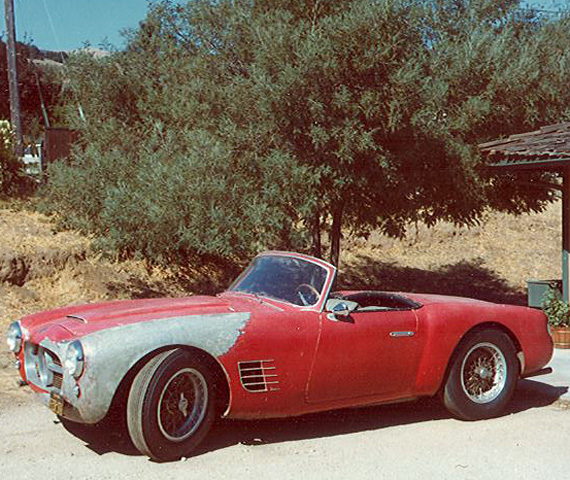
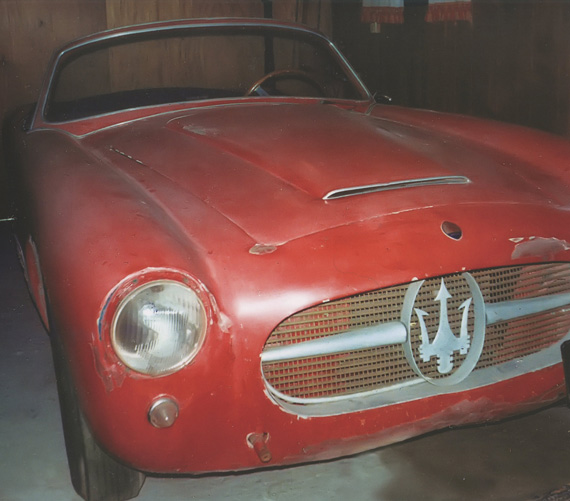

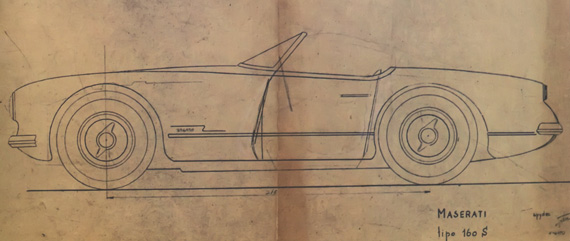
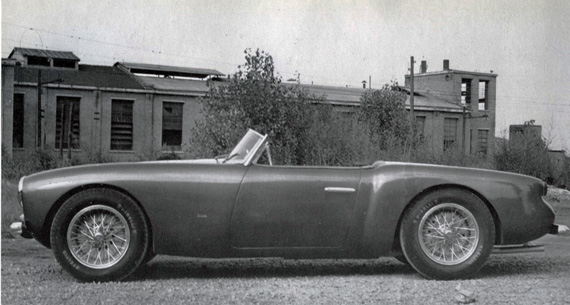
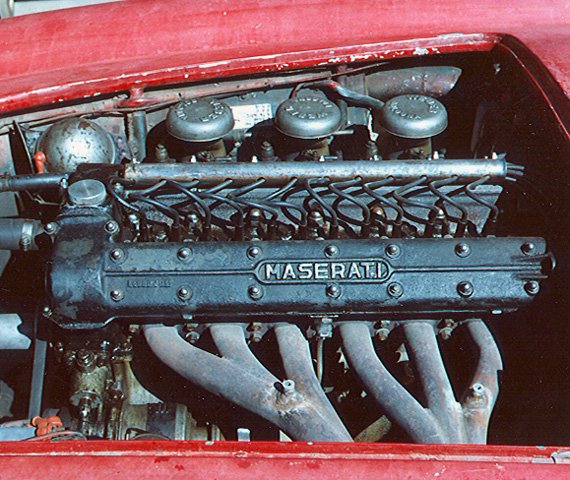
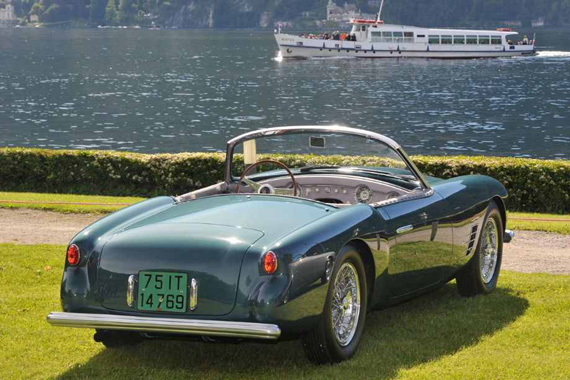
Oh well, $4,455,000 is only 5569 X the starting cost of $800.00!
My 51 Siata has the same screw on Weber filters shown on the Maser Zagato. Did they also us 32 DRP Weber carbs ? Does the car still have the original webers on it ?
More of the wonderful story. A man with enthusiasm, great taste and perseverance.
I lived in Carmel Valley in the middle 70s, not sure if I knew Mr. G. The place I lived had a non running Aston Martin DB2 convertible in a garage, the owner architect Will Shaw was a Pebble Beach Concours judge (as was Ansel Adams at that time) . Ken Schey lived in another house on the compound, he raced Minis and later Alfas for Griswold.
Once (during the first Monterey Historic’s race week) going over the Los Laureles Grade a yellow Ferrari Daytona pulled up behind my lowered Datsun 510 . I pulled over and let him pass. A few minutes later going down the other side of the Grade he didn’t have the courtesy to pull over for me. I knew the road, drove it several times a week so I hugged his bumper. Never had that opportunity again.
Lancia GT coupe in grey,,,could it possibly be the same one I saw
racing at Monterey Historics long ago, and driven by noted California
racer Jean-Pierre Kunstle,,,?
Seemed to me me he did borrow one when he came over from native Switzerland to re-visit Carmel where he lived in 1950s and racing 550 Porsche cars,
(almost beat Ken Miles at 1955 Torrey Pines event.!)
would be interested to know background of that Lancia,,wonderful car
thanks foe the memories
Jim sitz
I would crawl over 10 miles of ole’ broken Lone Star beer bottles on my hands and knees to get ahold of the keys to that car….. of course after I got the keys I’d just as quick wanta take ah-hold of the steering wheel and shift knob too… then I’d geaux tearing across the country side…. top down witha glorious straight six snarling , exhaust note reverberating off the canon walls … The sun would be beading down throwing a blinding flash off that huge chrome trident leading the way.
Zagato Nirvana and all would be right with the world…
Great story about a special car and Mr G obviously had the knack of finding them. I guess we can not expect to find such rare gems neglected in our own neighbourhood these days, but we can dream. My nearest lucky buy to that was a rare Mercedes and not relevant on VT but I always have had a preference for Maseratis over the other Italian thoroughbred marques. To add Zagato into the mix as my favourite carrossiere is the cherry on the cake.
The photo of the engine compartment shows the two exhaust headers. Look carefully and you can see on each header a small diameter cylindrical ‘riser’ welded (crudely) on the top which is internally-threaded. The Ferrari Daytona (1968-73) used this same design with longer ‘risers’. The purpose of the internally threaded risers is to mount an insulated reflective heat shield to reflect the heat from the headers. The Maser is missing its heat reflectors here in it’s $800 guise, not surprisingly, but I’d bet that they are there in it’s current state! What other Italian makes followed suit with this design?
I particularly enjoyed Part One of this article. Mr. G’s innovative solutions to problems encountered sounded like “normal activity” to me. Especially in those days given the general lack of information available at the time. This required me and car-guys I knew, to “figure out and do what needed to be done” as Mr.. G clearly did. (Only we had lesser cars to fool with than Mr. G!) The “figuring out” often is as rewarding as the “doing”.
if anyonc knows about starting a new chapter in their life,it’s certainly Brandes Elitch.
Thegreat thing about this is that everything seems to get better and better and this little tale is a perfect example.
WELL DONE BRANDES!
Hi, I am pretty sure the B20S is s/n 1227, on which I have some detailed history.
The owner after Mr G corresponded with me in the 1970s, when he was restoring the car. It had been light blue was being painted red.
Apparent the car had been at the 1956 Pebble Beach Concours.
More recently the car was advertised in yet another colour – amaranto – the deep maroon and I think was sold in 2008 and was later in Montana, USA, no longer with its UYN 144 registration. It still has the original column gearshift.
Hi, I am the restorer of this Maserati, It was a blast to do and only took two years
and less money than I first thought. I had a chance to meet both Mr. G and
the Air Force pilot, both real great guys. Mr. Santos the pilot actually drove the
Maserati from Virginia to Carmel when he retired from the Air Force.
Both Men were helpful with the restoration. Mr. Santos even sent me some original parts and photos that he still had.
We are always on the look out for more cars like this to restore.
Ed Nelson
Genoa Racing
Novato, Ca (415) 883-4824
sent me
the original knobs for the dashboard and a number of old photos
What an incredible and fascinating story! This tops any story about some lost and found endeavors of Stradivarius instrument through the ages… As far as the gift from the mother to a rather (shall we say) capricious kid, little she knew she was attempting to kill an ant with a sledgehammer! 🙂